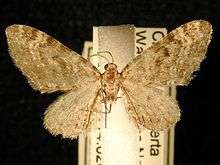Eupithecia niveifascia
Eupithecia niveifascia is a moth in the family Geometridae first described by George Duryea Hulst in 1898. It is found in North America from south-western Alberta west to Vancouver Island, north to northern coastal British Columbia and south to New Mexico.[3]
| Eupithecia niveifascia | |
|---|---|
 | |
| Scientific classification | |
| Kingdom: | Animalia |
| Phylum: | Arthropoda |
| Class: | Insecta |
| Order: | Lepidoptera |
| Family: | Geometridae |
| Genus: | Eupithecia |
| Species: | E. niveifascia |
| Binomial name | |
| Eupithecia niveifascia | |
| Synonyms | |
| |
The wingspan is 17–19 mm. The forewings are pale cream with darker yellow-brown and light grey parallel crosslines. The hindwings are white or cream with yellow-brown markings on the lower half and with dark discal bars.[4] Adults have been recorded on wing from the end of May to mid-July.
References
- Yu, Dicky Sick Ki. "Eupithecia niveifascia (Hulst 1898)". Home of Ichneumonoidea. Taxapad. Archived from the original on March 25, 2016.
- "910405.00 – 7566 – Eupithecia niveifascia – (Hulst, 1898)". North American Moth Photographers Group. Mississippi State University. Retrieved May 2, 2019.
- Rindge, Frederick H. (July 25, 1963). "Notes on and descriptions of North American Eupithecia (Lepidoptera, Geometridae)" (PDF). American Museum Novitates. 2147: 1–23.
- Anweiler, G. G. (2007). "Species Page - Eupithecia niveifascia". Entomology Collection. University of Alberta E.H. Strickland Entomological Museum. Retrieved May 2, 2019.
| Wikimedia Commons has media related to Eupithecia niveifascia. |
| Wikispecies has information related to Eupithecia niveifascia |
This article is issued from Wikipedia. The text is licensed under Creative Commons - Attribution - Sharealike. Additional terms may apply for the media files.